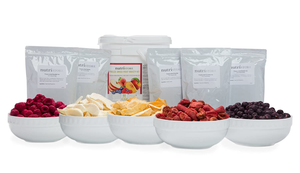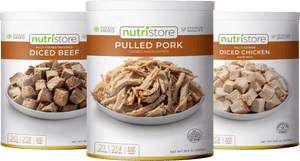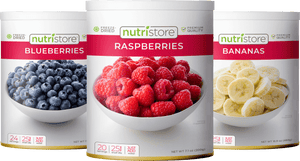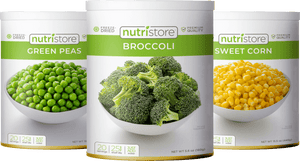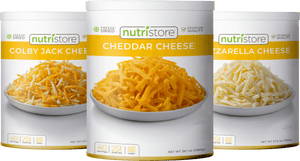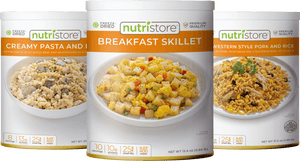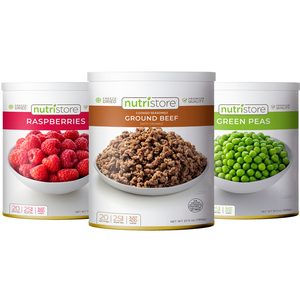Is Freeze Dried Food the Same as Dehydrated Food?
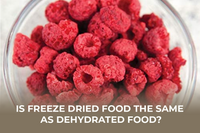
Oftentimes the terms “freeze-dried” and “dehydrated” are used interchangeably when speaking of dried food. This creates the illusion that these labels are exactly the same, but surprisingly they are not. Even though both freeze-drying and dehydration result in a shelf-stable food product, the processes are very different and the results vary just as much. Knowing the difference helps when deciding which products to store and serve to your family.
The term “dried food” simply means that the water content of the food has been reduced. This can be done through old-fashioned methods like air and sun drying, or by using more modern appliances like dehydrators, freezers, and vacuums. It is important to understand that while all dehydrated or freeze-dried food is “dry food”, not all “dry food” is dehydrated or freeze-dried. Simply stated, not all dried food is processed the same nor is it created equally.
Answering the question “is freeze-dried food the same as dehydrated food” would not be sufficient without diving into the history of these methods, the specific process of drying, the key differences and similarities, and ultimately showing you which type of dried food is best for you.
History of Dried Foods
There is one thing in common in every type of long-term food preservation, that is the removal of moisture. Ancient civilizations discovered this and began the development of safely and effectively storing foods for long periods of time. It is from these early discoveries that dehydration and freeze-drying exist.
History of Dehydration
There is no exact date or evidence that teaches the inception of dehydration, however, the practice can be found in history as early as 12,000 BC. Egyptians first used desert heat to dry fish and poultry. In the Middle Ages, residents of the cooler, wetter regions of Europe began to construct structures, called stillhouses, that were specifically designed for this dehydration process. Inside the stillhouse, all types of food were strung across the room to be dried by the heat of a fire. The dehydrating of foods also developed alongside the industrial revolution and was mechanized by French inventors. One of the greatest impacts of dehydrated food then came during World War II, when troops needed small, lightweight, and stable rations, thus implementing the use of MREs (meal ready to eat). The popularity of dehydrated food today has continued to grow, especially among campers and hikers, for its lightweight and excellent transportability.
History of Freeze-Drying
The rudimentary form of freeze-drying food can be dated back to the 15th century Incas, when crops were stored at the height of mountain tops above Machu Picchu. Here the cold mountain temperatures froze their food stores, and the water inside slowly vaporized under the low air pressure of high altitudes. Like dehydration, modern freeze-drying techniques were initially developed and used during World War II. Blood sent to Europe to aid in US medical treatments was spoiling before reaching their destinations because of the lack of required refrigeration. The freeze-drying process became the commercial technique that enabled this needed blood to be rendered stable and viable without a refrigerator. This process was then applied to other aspects of the medical field and has been recognized as an important technique for the preservation of numerous materials. Since the time of war, freeze-dried products, primarily foods, began to gain widespread popularity, beginning first when NASA created freeze-dried ice cream, the famous astronaut food. The process of freeze-drying has become more commonplace within the food industry as the everyday use of freeze-dried food begins to gain momentum.
Processes of Drying
Every process of drying food, including dehydration and freeze-drying, focuses on the removal of moisture so that the food doesn’t decompose and grow bacteria or mold. Achieving this without destroying the food’s composition, decreasing the food’s nutritional value, and maintaining the food’s shelf stability is the primary challenge at hand.
Process of Dehydration
The process of dehydrating food can only be done with airflow and heat. The combination of these with the moisture of the food determines the longevity of the product's shelf-life. When done in an electrical dehydration device, dehydration removes between 90-95% of the moisture. This is accomplished by circulating hot and dry air across the food. This moist air is then dried so that water continues to be drawn out of the product. These temperatures are high enough to remove water but not high enough to cook the food. The dehydration process usually results in food that is withered and harder.
Process of Freeze-Drying
Producing freeze-dried food is a much more complex process when compared to dehydration. Freeze-drying requires specialized equipment. The food goes through a somewhat “opposite” process as opposed to dehydration. Food is subjected to extremely low temperatures until frozen. Once this temperature is reached, a vacuum is then formed around the food and the temperature is raised slowly. The heat energy causes frozen water to sublime (frozen liquids are converted to vapor without going through a liquid phase). Because of the unique process of sublimation, 98%-99% of the moisture is removed. The properties of freeze-dried food will also maintain the original structure and nutritional value of the good.
Similarities
Even though the processes of creating shelf-stable foods differ, there are a few key similarities when it comes to freeze-drying and dehydration. The method(s) of preservation is the reduction of the moisture content of the food, which prevents the growth of microorganisms including mold, yeast, and bacteria. Also, either type of dried food storage in cool temperatures will increase the shelf life. As you can see there are limited similarities and the differences are an important factor in considering which type of dried food is best for you.
Differences
There are fundamental differences between freeze-dried and dehydrated food. When looking for reliable, tasty, healthy, high-quality food, understanding these differences is essential. A few key differences are moisture content, shelf life, and nutritional value. These are the factors that should be focused on when deciding the type(s) of dried goods you need. The other differences listed are contributing factors but are considered processing differences or differences that can be based upon opinion.
|
Freeze Dried |
Dehydrated |
|
|
Process |
Sublimation |
Evaporation |
|
Temperature |
Low-Temperature |
High-Temperature |
|
Moisture Content |
98%-99% removed |
90%-95% removed |
|
Shelf Life |
~25 Years |
~10 Years |
|
Nutritional Value |
~99% Nutrients Retained |
~60% Nutrients Lost |
|
Texture |
Light and Crispy |
Withered and Hard |
|
Weight |
Lighter than Dehydrated Product |
Lighter than Original Product |
|
Additives/Preservatives |
No required additives |
Requires small amounts of additives |
Conclusion
In the grand scheme of things, freeze-drying is the more favorable method of food preservation, resulting in the removal of 99% of the food’s moisture through freezing temperatures, and providing longer shelf life (25 years). This process also retains a high amount of nutrients in the food while keeping the original flavor, taste, smell, and texture of the food.
So… Is freeze-dried food the same as dehydrated?
The answer is a simple and resounding NO! Throughout every step, these two food preservation techniques create vastly different effects on the food and provide very different benefits!
Comments (1)
if i get some of your freeze dried foods does it has the look of the actual fruit or veggie? and do I just heat it up to use it?
Leave a Comment
You May Also Like

How Long Freeze Dried Food Really Lasts & The 4 Threats to Shelf Life
Ever wondered how long freeze dried food lasts before and after it is opened? Understanding these 4 shelf life factors will give you more peace of mind in storing your products.

7 Best Tips to Improve Your Emergency Food Storage Supply
Follow these 7 simple steps to help make your long-term bulk survival food supply ready for any size emergency!

